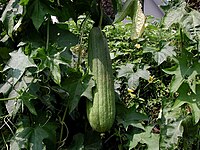
Photo from wikipedia
Abstract White milled rice contains reduced nutritional value as a result of milling and polishing processes. This work explored a simple approach of fortifying rice through surface modification and vitamin… Click to show full abstract
Abstract White milled rice contains reduced nutritional value as a result of milling and polishing processes. This work explored a simple approach of fortifying rice through surface modification and vitamin adsorption. Exposure of white long grain rice to ultrasonic environment modified the surface from smooth to porous. Morphological analysis revealed that sonication promoted fragmentation and destruction of the surface shell and induced the formation of micropores, exposure of cell walls, and disintegration of starchy endosperm into individual starch granules. Soaking the sonicated rice in a solution of pantothenic acid (vitamin B 5 ) allowed the adsorption of the vitamin into the rice grain. The uptake of vitamin B 5 in sonicated rice is 140.0% higher than the non-sonicated rice. The kinetic study indicates the rate of adsorption in porous sonicated rice is 93.9% higher than the non-sonicated rice. Adsorption investigation showed heterogeneous binding mechanism indicating the critical role of the modified porous surface of rice grain in the fortification process.
Journal Title: Lwt - Food Science and Technology
Year Published: 2018
Link to full text (if available)
Share on Social Media: Sign Up to like & get
recommendations!